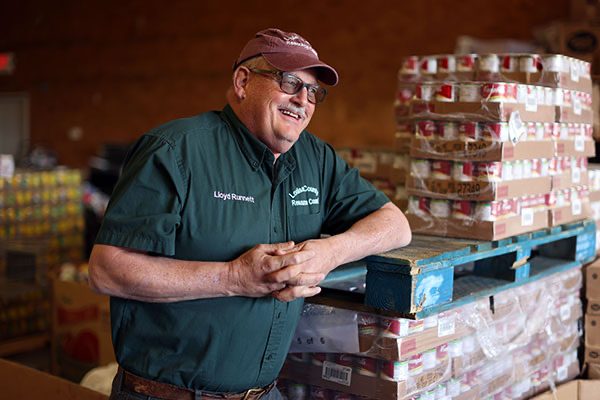Living Well
Stroke Survivor Lloyd Runnett
From lifelong dedication to emergency medicine to finding himself on the other side of the stretcher

Lloyd Runnett’s lifelong dedication to emergency medicine took an unexpected turn on August 27, 2023, when he found himself on the other side of the stretcher.
Before becoming executive director of the Louisa County Resource Council, Runnett was chief of emergency medical services and special operations for Henrico County, Va. With more than five decades of EMT experience, he never imagined being the patient needing immediate care.
The day started like any other, with Runnett of Mineral, Va. and his wife, Lynne, attending church, unaware of an imminent crisis. Runnett remembers their quiet afternoon relaxing at home afterward, occasionally chatting. Suddenly, Runnett, age 62 at the time, was struck by symptoms of a severe stroke, rendering him unable to communicate or move properly.
Runnett remained fully aware of what was happening despite being incapacitated in a matter of seconds.
“I knew I had left side weakness, and I knew I was having a serious stroke,” he recalls, “But it was like being in a movie where I didn’t have a speaking part. I could see and hear everything going on, but I couldn’t communicate.”
With her intuitive sense honed by years of marriage, Lynne swiftly recognized something was wrong and called for help.
“The funny thing about being married for a long time…is that intuition kicks in,” he continues.
Thanks to the quick response of Louisa County Fire/EMS, which coincidentally dispatched the team Runnett once led as chief, he was swiftly transported to the Sentara Martha Jefferson Hospital in Charlottesville, Va.
Despite his inability to speak or move, Runnett’s vast knowledge of emergency procedures allowed him to comprehend the gravity of his condition.
“I listened to them taking my vitals, pre-alerting the hospital that a stroke patient was coming in, and I was even reading my own EKG,” he remembers. “I knew I was in good hands and that everything was set in motion for me to be treated successfully.”
Runnett believes two of the reasons he’s alive are that his wife and the medic crew responded so quickly. When he arrived at Sentara Martha Jefferson Hospital, Runnett received rapid and expert care.
“From the time of the initial 911 call to me receiving the stroke medication and my time in the ICU, I got wonderful care,” he notes.
Runnett experienced a gradual improvement in his condition. However, his journey to recovery took an unexpected and mysterious turn when he needed open-heart surgery due to an underlying mechanical issue—a complication rarely seen in someone of his age.
“I felt like I was on an episode of ‘House,'” says Runnett, referring to the TV medical drama. “They brought in the ‘closers’ to figure out what was happening. They even asked about things I’d been exposed to while working with FEMA.”
Throughout this ordeal, Runnett remained resilient, supported by his healthcare team’s dedication and his family’s unwavering love. He credits the seamless coordination between Sentara Martha Jefferson Hospital and a nearby hospital, where he was transferred for open heart surgery and valve replacement, as a big part of his recovery.
“If I had gone to another hospital or hadn’t gotten the medication as quickly as I had, we would be having a very different conversation today,” Runnett adds.
Reflecting on his experience, Runnett emphasizes the importance of knowing one’s body and acting swiftly in the face of medical emergencies. His story serves as a testament to the critical role of preparedness, timely intervention and collaborative care in overcoming life-threatening conditions like stroke.
Living Well After Stroke
More than 6 million Americans are stroke survivors. Learn how to live well after a stroke.
Learn More